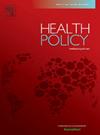城市二氧化氮污染和健康结果:来自意大利的一项关于欧盟零排放车辆决议模拟效益的自然实验的证据
IF 3.4
3区 医学
Q1 HEALTH CARE SCIENCES & SERVICES
引用次数: 0
摘要
欧盟的“Fit-For-55″”决议规定,2035年以后禁止销售化石燃料汽车。由于该决议在减少全球二氧化碳排放方面的效果不确定,引发了激烈的争论。然而,欧盟向零排放车辆的转变有可能减少城市二氧化氮(NO2)污染,这种污染与呼吸系统和心血管疾病以及死亡率增加密切相关。本文旨在模拟过渡期后欧盟零排放交通政策对城市二氧化氮和健康结果的影响。该分析利用了意大利北部空气污染数据和意大利Covid-19封锁的一些独特特征,将其作为自然实验来模拟该政策预期的化石燃料交通减少。我们的估计是通过开发一种新的跨时间统计匹配方法获得的,该方法特别适合于空气污染多元时间序列背景下的准实验评估。结果我们发现,封锁导致二氧化氮平均减少13.62 μg/m³(比25.8 μg/m³的基线减少53%),这意味着总死亡率、心血管死亡率和呼吸系统死亡率的相对风险分别降低8.3、7.5和3.8个百分点。我们还估计了影响的异质性,在较高的基线污染水平下,二氧化氮和死亡风险的对数线性下降幅度较大。这些结果表明,欧盟的零排放交通政策有望改善高交通密度城市地区的空气质量和公共卫生,尽管由于气象条件和城市/地形特征的差异,不同地区的效益可能有所不同,支持空间差异化的政策实施。本文章由计算机程序翻译,如有差异,请以英文原文为准。
Urban NO2-pollution and health outcomes: Evidence from a natural experiment in Italy on the simulated benefits of the EU zero-emission-vehicles resolution
Background
The EU “Fit-For-55″ resolution provisions the banning of fossil-fuel-vehicle sales beyond 2035, sparking a heated debate due to its uncertain effectiveness in reducing CO2 emissions globally. Nevertheless, the EU shift towards zero-emission vehicles has the potential to decrease urban nitrogen dioxide (NO2) pollution that is closely linked to respiratory and cardiovascular diseases and to increased mortality.
Objective
This paper aims to simulate the impact that the EU zero-emission-mobility policy is expected to have, post-transitional period, on urban NO2 and health outcomes.
Methods
The analysis exploits some unique features of Northern-Italy air-pollution data and the Italian Covid-19 lockdown that is leveraged as a natural experiment to mimic the fossil-fuel traffic abatement expected by the policy. Our estimates are obtained by developing a novel intertemporal-statistical-matching approach specifically suited for quasi-experimental evaluations in the context of air-pollution multivariate time series.
Results
We find that the lockdown led to a mean NO2 reduction of 13.62 μg/m³ (53 % from a baseline of 25.8 μg/m³), translating into a simulated reduction in the relative risk of total, cardiovascular, and respiratory mortality by 8.3, 7.5 and 3.8 percentage points, respectively. We also estimate impact heterogeneity, with log-linearly larger reductions in NO2 and mortality risk at higher baseline-pollution levels.
Conclusions
These results imply that the EU zero-emission mobility policy is expected to improve air-quality and public health in urban areas with high traffic density, though benefits may vary across regions due to differences in meteorological conditions and urban/orographic characteristics, supporting a spatially differentiated policy implementation.
求助全文
通过发布文献求助,成功后即可免费获取论文全文。
去求助
来源期刊

Health Policy
医学-卫生保健
CiteScore
6.40
自引率
6.10%
发文量
157
审稿时长
3-8 weeks
期刊介绍:
Health Policy is intended to be a vehicle for the exploration and discussion of health policy and health system issues and is aimed in particular at enhancing communication between health policy and system researchers, legislators, decision-makers and professionals concerned with developing, implementing, and analysing health policy, health systems and health care reforms, primarily in high-income countries outside the U.S.A.
 求助内容:
求助内容: 应助结果提醒方式:
应助结果提醒方式:


